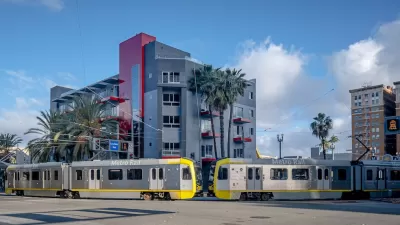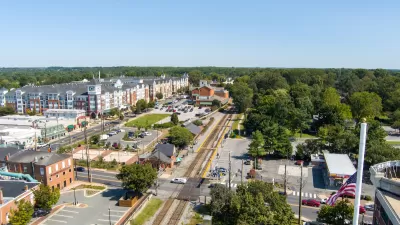Across America, TOD is seen as the solution for many of the problems that plague cities. But what if you could get the economic, environmental, and health benefits of transit-oriented development without the billions of dollars in rail investment?
To remedy the effects of several decades of sprawling development patterns, cities throughout the United States are pursuing the development of high-density pedestrian-friendly neighborhoods oriented around transit stations. "All that would encourage people to walk, bicycle and use transit instead of driving," says Marlys Harris. "Air would get cleaner, dependence on foreign oil would drop, and a thousand flowers would bloom."
"But here's the crucial question: Does TOD really decrease driving?"
"Studies have come down on both sides of the issue," she notes. "The latest, from Daniel G. Chatman, assistant professor of urban and regional planning at the University of California, Berkeley, made a pretty thorough investigation of the matter and concluded that people living in TOD areas did drive less, but — and here's the surprise — not because of the availability of transit."
"Instead of making multi-billion dollar investments in rail transit, Chatman argues, we may be able to reduce energy use and pollution just as much by creating incentives for higher-density mixed-use developments (incorporating housing, retail and offices) in certain areas while strictly limiting parking. Problem is, the local inconveniences of greater congestion and less parking would probably tick off neighbors and their elected representatives. Working all that out, he says,'is the planning puzzle that deserves our focused attention. The pursuit of rail-oriented development may be a distraction.'"
FULL STORY: Do we really need mass transit to limit our dependence on cars?

Maui's Vacation Rental Debate Turns Ugly
Verbal attacks, misinformation campaigns and fistfights plague a high-stakes debate to convert thousands of vacation rentals into long-term housing.

Planetizen Federal Action Tracker
A weekly monitor of how Trump’s orders and actions are impacting planners and planning in America.

In Urban Planning, AI Prompting Could be the New Design Thinking
Creativity has long been key to great urban design. What if we see AI as our new creative partner?

King County Supportive Housing Program Offers Hope for Unhoused Residents
The county is taking a ‘Housing First’ approach that prioritizes getting people into housing, then offering wraparound supportive services.

Researchers Use AI to Get Clearer Picture of US Housing
Analysts are using artificial intelligence to supercharge their research by allowing them to comb through data faster. Though these AI tools can be error prone, they save time and housing researchers are optimistic about the future.

Making Shared Micromobility More Inclusive
Cities and shared mobility system operators can do more to include people with disabilities in planning and operations, per a new report.
Urban Design for Planners 1: Software Tools
This six-course series explores essential urban design concepts using open source software and equips planners with the tools they need to participate fully in the urban design process.
Planning for Universal Design
Learn the tools for implementing Universal Design in planning regulations.
planning NEXT
Appalachian Highlands Housing Partners
Mpact (founded as Rail~Volution)
City of Camden Redevelopment Agency
City of Astoria
City of Portland
City of Laramie





























